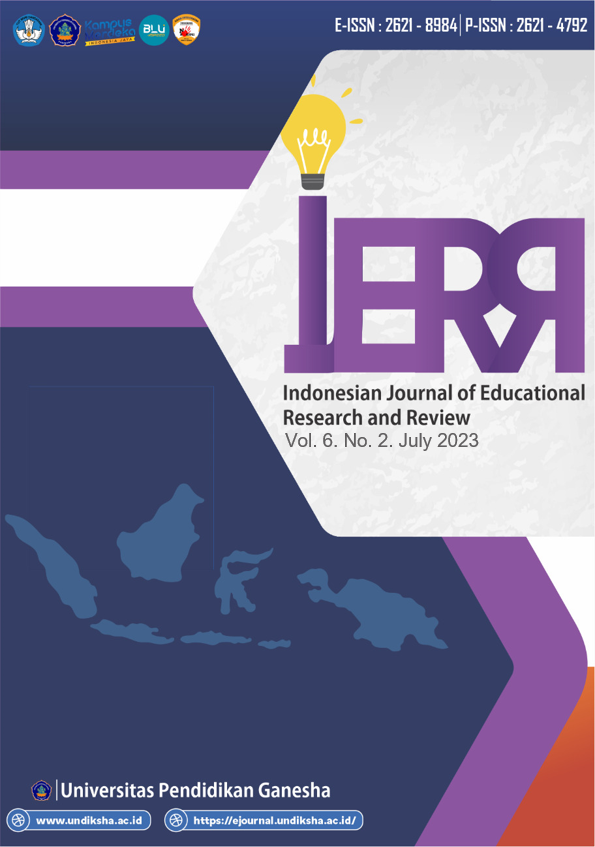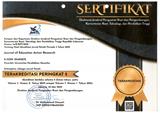Invitation Strategy and Learners’ Controlled Politeness: A Case in Indonesian Students of EFL
DOI:
https://doi.org/10.23887/ijerr.v6i2.65622Keywords:
Invitation Strategy, Politeness, Control, Indonesian Learners, EFLAbstract
Politeness strategies in making invitations appear to vary. The fact that there are politeness strategies in invitations of different forms covered by scientific theories raises ideas for further research. Therefore this study analyze how Indonesian learners of English as a foreign language (EFL) performed invitation strategies and controlled politeness. The research participants were 244 Indonesian learners of EFL in vocational higher education in Bali, Indonesia. The data were semantic realization of invitation performed by participants pursuant to discourse completion cards. The role play cards based on which the data were taken were divided into two divisions, role play card for hearers (Hs) with high power, high distance and high rank of imposition (P+D+R+) and low power, low distance, and high rank of imposition (P-D-R+). Data were analysed qualitatively. Analysis result revealed that there were nine new strategies of invitation. Speakers controlled politeness by a number of strategi, such as using ‘bi-clause sentences and if-conditional sentences, indirect sentences, passive sentences, formal sentences and markers such as would, could, look forward, please, Mr, Mr. director, sir, local both traditional and religious expressions, utterances with asking for permission, utterances with expression of permission, appreciation, apology to invite Hs with P+D+R+. In order to invite Hs with P-D-R+, S tended to use mono clauses and simple sentences, direct sentences, less formal sentences such as do, want, are, want, can, don’t, simple sentence, active sentences, intimacy greeting such as hallo, friends, hi guys, informal expression of suggestion, promise, imperative sentences, and direct sentences of willingness.
References
Adel, S. M. R., Davoudi, M., & Ramezanzadeh, A. (2016). A qualitative study of politeness strategies used by Iranian EFL learners in a class blog. Iranian Journal of Language Teaching Research, 4(1), 47–62. https://doi.org/10.30466/IJLTR.2016.20377.
Al-Hamzi, A. M. S., Sartini, N. W., Hapsari, N. F., Gougui, A., & Al-Nozili, R. M. A. (2020). A Cross-Cultural Pragmatic Study of Invitation Strategies As Produced by Indonesian and Yemeni EFL Language Learners. International Journal of Applied Linguistics and English Literature, 9(6), 42–53. https://doi.org/10.7575/aiac.ijalel.v.9n.6p.42.
Brown, P., & Levinson, S. C. (1978). Universals in language usage: Politeness phenomena. In Questions and Politeness: Strategies in Social Interaction, 56–311.
Dewi, M. I. K., Budasi, I. G., & Ramendra, D. P. (2017). An Analysis Of Balinese Swear Words Used In Cempaga Village. Jurnal Pendidikan Bahasa Inggris Undiksha, 5(2). http://download.garuda.kemdikbud.go.id/article.php?article=839130&val=5108&title=an analysis of swear wordsof balinese language practices by bali aga people in cempaga villagenorth bali.
Djafar, H., Wahid, J. H. J., & Sahmadan, S. (2022). Students ’ Language Attitudes and Politeness as Character Education in the Implementation of Merdeka Belajar Kampus Merdeka ( MBKM ). Budapest International Research and Critics Institute-Journal (BIRCI-Journal), 5(2), 16028–16036. https://doi.org/DOI: https://doi.org/10.33258/birci.v5i2.5519 16028.
Efrianto, E., & Afnita, A. (2019). The Politeness of Bungo Pasang Language Using Kato Nan Ampek in Minangkabau. Jurnal KATA, 3(1). https://doi.org/10.22216/kata.v3i1.3489.
Fatimah, A. S., & Santiana, S. (2017). Teaching in 21St Century: Students-Teachers’ Perceptions of Technology Use in the Classroom. Script Journal: Journal of Linguistic and English Teaching, 2(2), 125. https://doi.org/10.24903/sj.v2i2.132.
George, E. J., & Mamidi, R. (2020). Conversational implicatures in English dialogue: Annotated dataset. Procedia Computer Science, 171(2019), 2316–2323. https://doi.org/10.1016/j.procs.2020.04.251.
Grabe, W. (2014). Key Issues in L2 Reading Development. 4th CELC Symposium Proceedings, 8–18. https://blog.nus.edu.sg/celcblog/files/2021/12/Alternative-pedagogies-in-the-English-language-Communication-classroom-4th-CELC-Symposium_2014.pdf#page=13.
Guswita, K. A., & Andriyanti, E. (2020). Conversational implicature in English learning process at senior high school in Yogyakarta. 240 Metalingua, 18(2), 239–250. https://doi.org/10.26499/metalingua.v18i2.548.
Hashim, H. U., Yunus, M. M., & Hashim, H. (2018). Language learning strategies used by adult learners of teaching english as a second language (tesl). TESOL International Journal, 13(4), 39–48. https://eric.ed.gov/?id=EJ1244116.
Hitchcock, M., & Dann, G. M. S. (1998). The Language of Tourism: A Sociolinguistic Perspective. In The Journal of the Royal Anthropological Institute (Vol. 4, Issue 3). Cab International. https://doi.org/10.2307/3034171.
Isabella, R. A., Simanjuntak, N., Simaremare, R. M., & Sitorus, N. (2022). An Analysis of Politeness Strategy Used in Bataknese Traditional Wedding Ceremony: a Case on Pragmatics. American Journal of Art and Culture, 1, 18–26. https://americanjournal.org/index.php/ajac/article/view/73.
Khusniati, M., Parmin, & Sudarmin. (2017). Local wisdom-based science learning model through reconstruction of indigenous science to improve student’s conservationist character. Journal of Turkish Science Education, 14(3), 16–23. https://doi.org/https://doi.org/10.12973/tused.10202a.
Kurdghelashvili, T. (2015). Speech acts and politeness strategies in an EFL classroom in Georgia. International Journal of Cognitive and Language Sciences, 9(1), 306–309. https://doi.org/10.5281/zenodo.1338098.
Lyon, A. R., Coifman, J., Cook, H., McRee, E., Liu, F. F., Ludwig, K., & McCauley, E. (2021). The Cognitive Walkthrough for Implementation Strategies (CWIS): a pragmatic method for assessing implementation strategy usability. Implementation Science Communications, 2(1), 1–16. https://doi.org/10.1186/s43058-021-00183-0.
Maharani, T. (2018). A Study of Politeness Strategies Used by Hillary Clinton and Donald Trump On The Second Presidential Debate.
Mahmud, M. (2019). The use of politeness strategies in the classroom context by English university students. Indonesian Journal of Applied Linguistics, 8(3), 597–606. https://doi.org/10.17509/ijal.v8i3.15258.
Mohammad, S., Adel, R., Davoudi, M., & Ramezanzadeh, A. (2016). A qualitative study of politeness strategies used by Iranian EFL learners in a class blog Iranian Journal of Language Teaching Research. Iranian Journal of Language Teaching Research, 4(1), 47–62. https://doi.org/10.30466/IJLTR.2016.20377.
Montag, J. L. (2019). Differences in sentence complexity in the text of children ’ s picture books and child-directed speech. First Language, 39(5), 527–546. https://doi.org/10.1177/0142723719849996.
Mustafai, J., Zeqiri, J., & Ceka, D. (2022). Sociological Aspects of digital learning. Journal of Positive School Psychology, 6(7), 1525–1533. https://www.journalppw.com/index.php/jpsp/article/view/11548.
Nassar, H. (2021). Reasons behind mis/understanding English conversational implicatures by University learners in Yemen. Studies in Pragmatics and Discourse Analysis, 2(1), 40–55. https://doi.org/10.48185/spda.v2i1.291.
Ouyang, F., & Scharber, C. (2017). The influences of an experienced instructor’s discussion design and facilitation on an online learning community development: A social network analysis study. Internet High. Educ., 35, 34–47. https://doi.org/10.1016/j.iheduc.2017.07.002.
Purwanti, N. K. R., Suwastini, N. K. A., Adnyani, N. L. P. S., & Kultsum, U. (2022). Youtube videos for improving speaking skills: The benefits and challenges according to recent research in EFL context. Jurnal Pendidikan Teknologi Dan Kejuruan, 19(1), 66–75. https://doi.org/https://doi.org/10.23887/jptk-undiksha.v19i1.41108.
Putri, I. G. A. V. W., & Nurita, W. (2021). Critical condition in Balinese lexicon extinction. Journal of Language and Linguistic Studies, 17(4), 1773–1786. https://doi.org/10.52462/jlls.129.
Rahmadani, & Wahyuni, D. (2018). Types and functions of address terms used by Ipmk-Sb “Kampar students studying in Padang.” E-Journal of English Language & Literature, 7(1), 132–142. https://doi.org/10.24036/ell.v7i1.9906.
Ratminingsih, N. M., Mahadewi, L. P. P., & Divayana, D. G. H. (2018). ICT-based interactive game in TEYL: Teachers’ perception, students’ motivation, and achievement. International Journal of Emerging Technologies in Learning, 13(9), 190–203. https://doi.org/10.3991/ijet.v13i09.8170.
Rovita, A., & Gulo, I. (2022). Politeness Strategy in Refusal of The Guests of The Ellen Show. Linguistics and Literature Journal, 3(1), 48–60. https://doi.org/10.33365/llj.v3i1.283.
Suandari, N. M. M., Simpen, I. W., & Malini, N. S. (2020). Language Attitudes among Balinese Workers in Cruise Ships toward Indonesian Language. American Journal of Humanities and Social Sciences Research (AJHSSR), 4(8), 362–365. https://www.ajhssr.com/wp-content/uploads/2020/08/ZQ2048362365.pdf.
Sudarmawan, I. P. Y., Juliari, I. I. T., & Yuniari, N. M. (2022). An Analysis Of Speech Act And Politeness Strategy Used By English Lecturer of Dwijendra University in Online Classroom Interaction. Yavana Bhasha: Journal of English Language Education, 5(2), 176–185. https://doi.org/10.25078/yb.v5i2.1039.
Togatorop, F. (2019). Politeness Strategies Used in the Conversation between the Students of Finance and Banking Department in Murni Sadar Polytehnic Pematangsiantar. Journal of English Teaching as a Foreign Language, 5(1), 37–48. http://ejournal.uhn.ac.id/index.php/jetafl/article/view/115.
Downloads
Published
How to Cite
Issue
Section
License
Copyright (c) 2023 I Made Rai Jaya Widanta, Luh Nyoman Chandra Handayani, I Wayan Dana Ardika

This work is licensed under a Creative Commons Attribution-ShareAlike 4.0 International License.
Authors who publish with the Indonesian Journal of Educational Research and Review (IJERR) agree to the following terms:
- Authors retain copyright and grant the journal the right of first publication with the work simultaneously licensed under a Creative Commons Attribution License (CC BY-SA 4.0) that allows others to share the work with an acknowledgment of the work's authorship and initial publication in this journal.
- Authors are able to enter into separate, additional contractual arrangements for the non-exclusive distribution of the journal's published version of the work (e.g., post it to an institutional repository or publish it in a book), with an acknowledgment of its initial publication in this journal.
- Authors are permitted and encouraged to post their work online (e.g., in institutional repositories or on their website) prior to and during the submission process, as it can lead to productive exchanges, as well as earlier and greater citation of published work. (See The Effect of Open Access)












